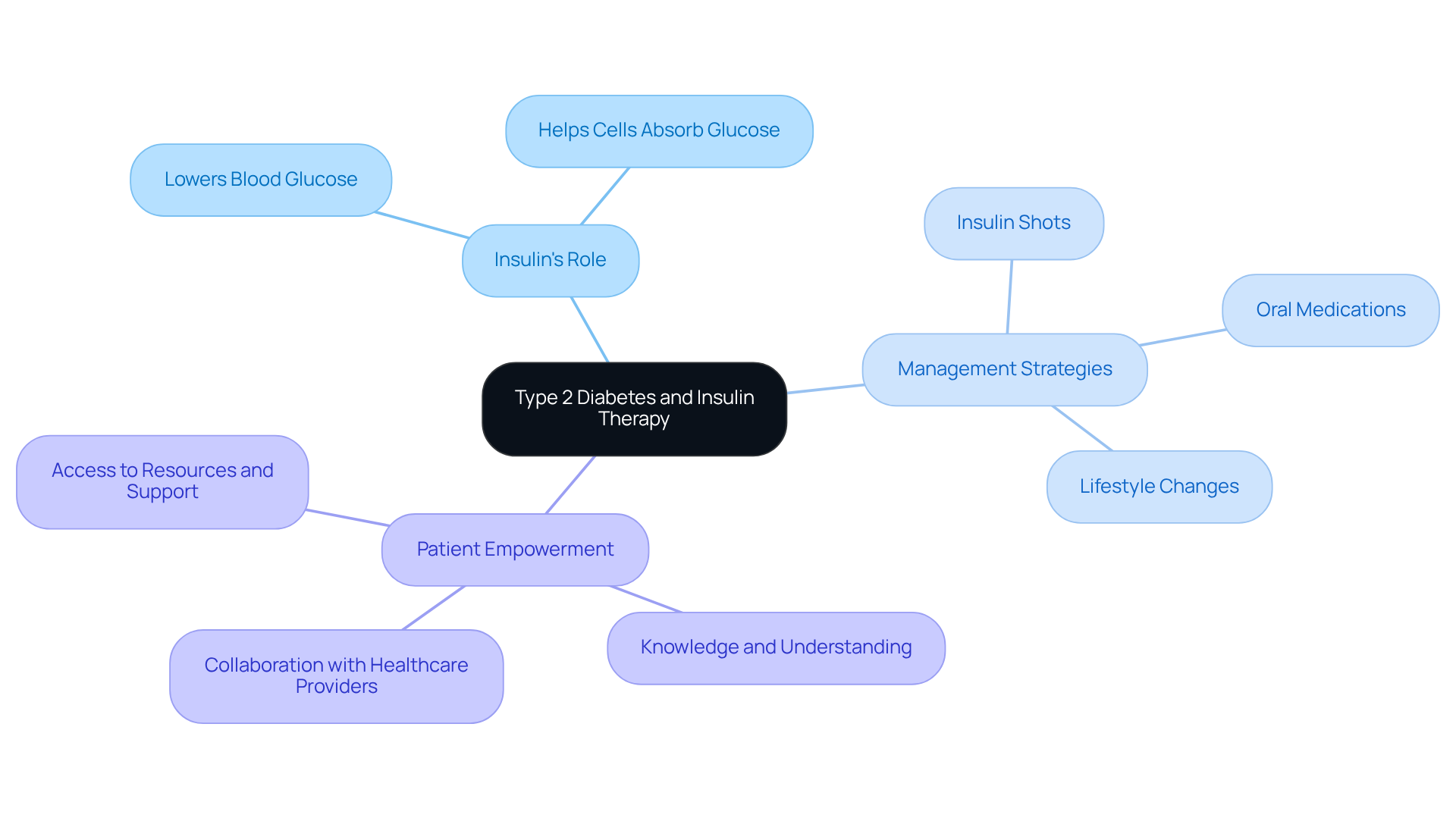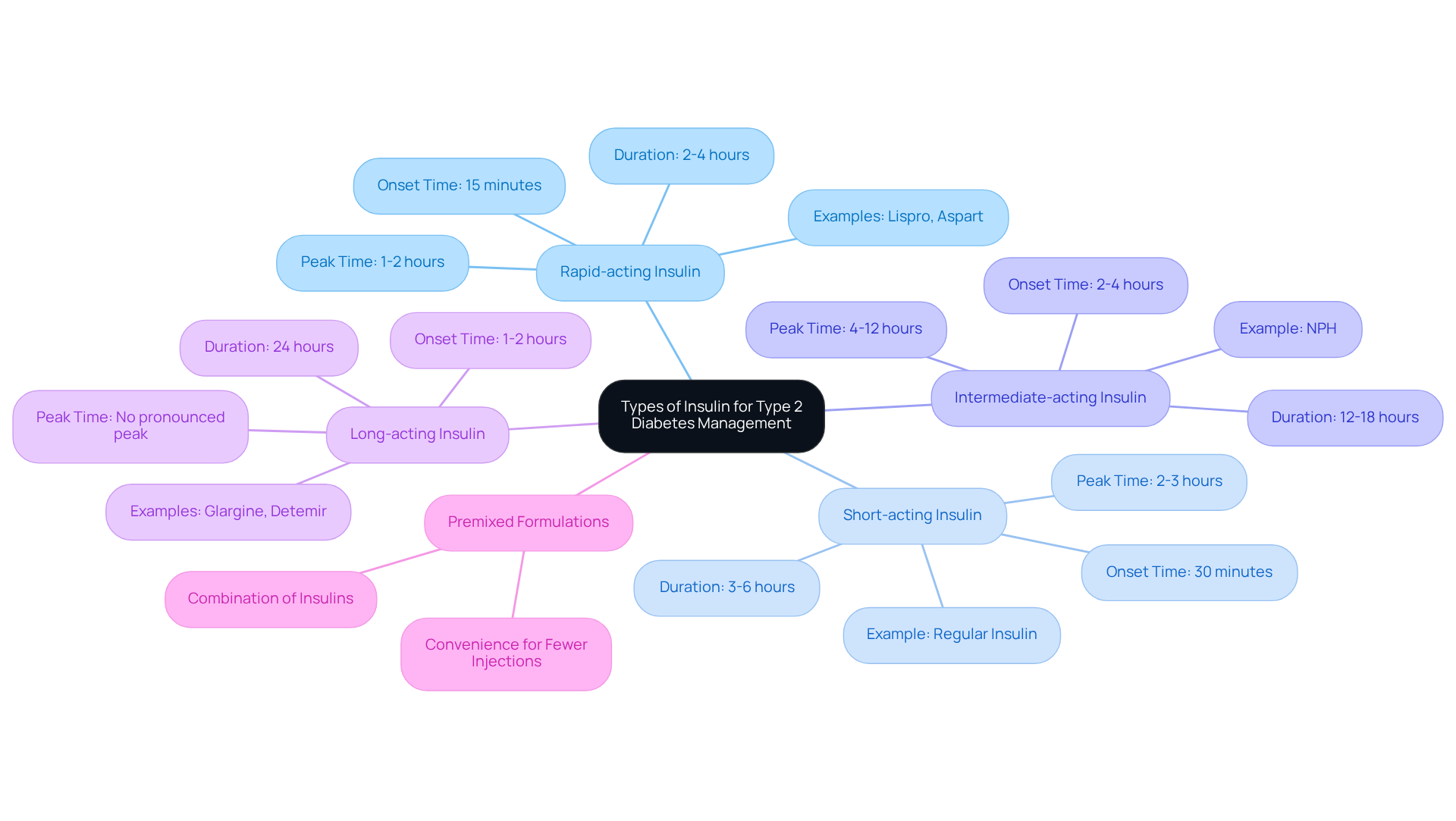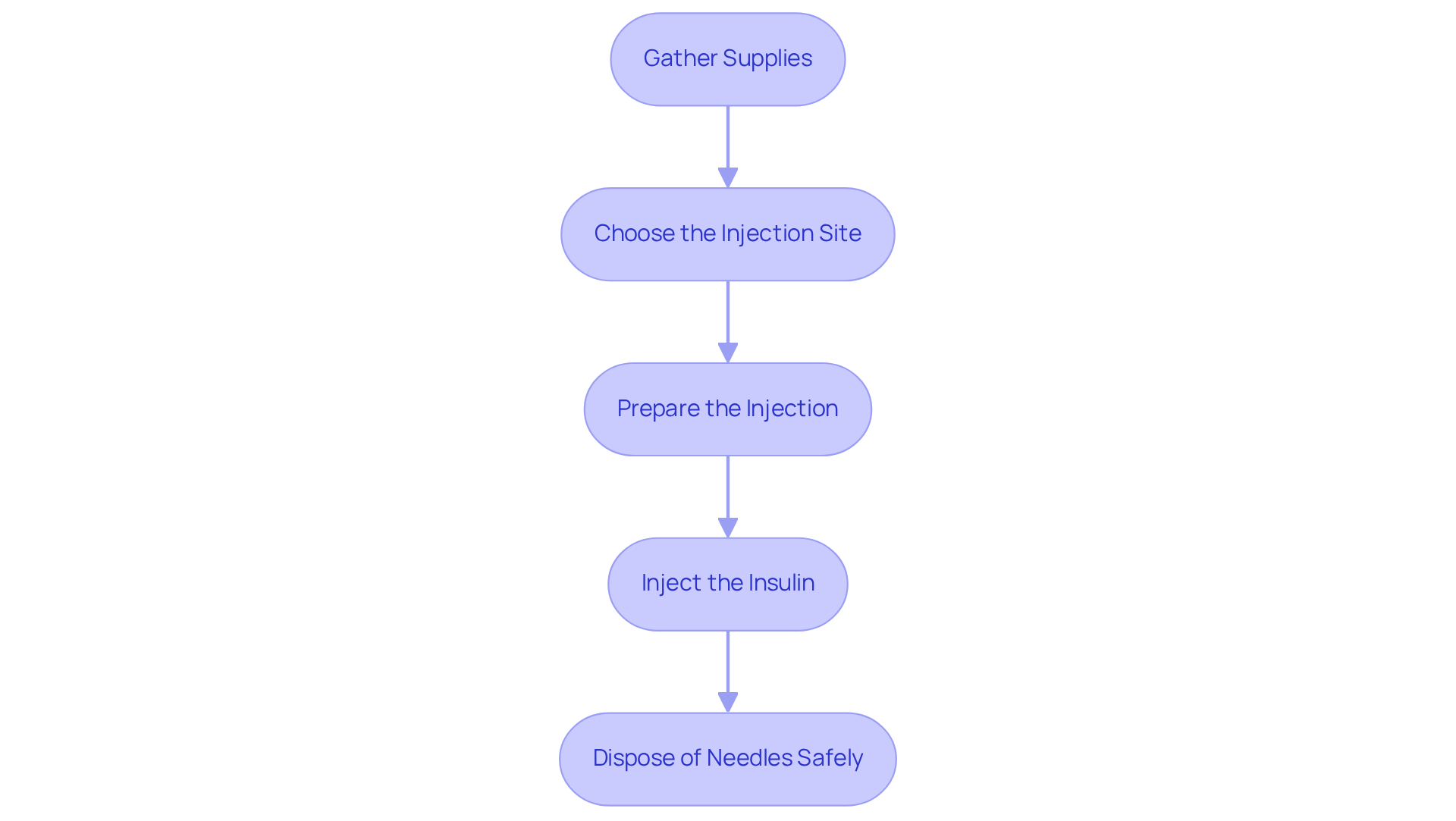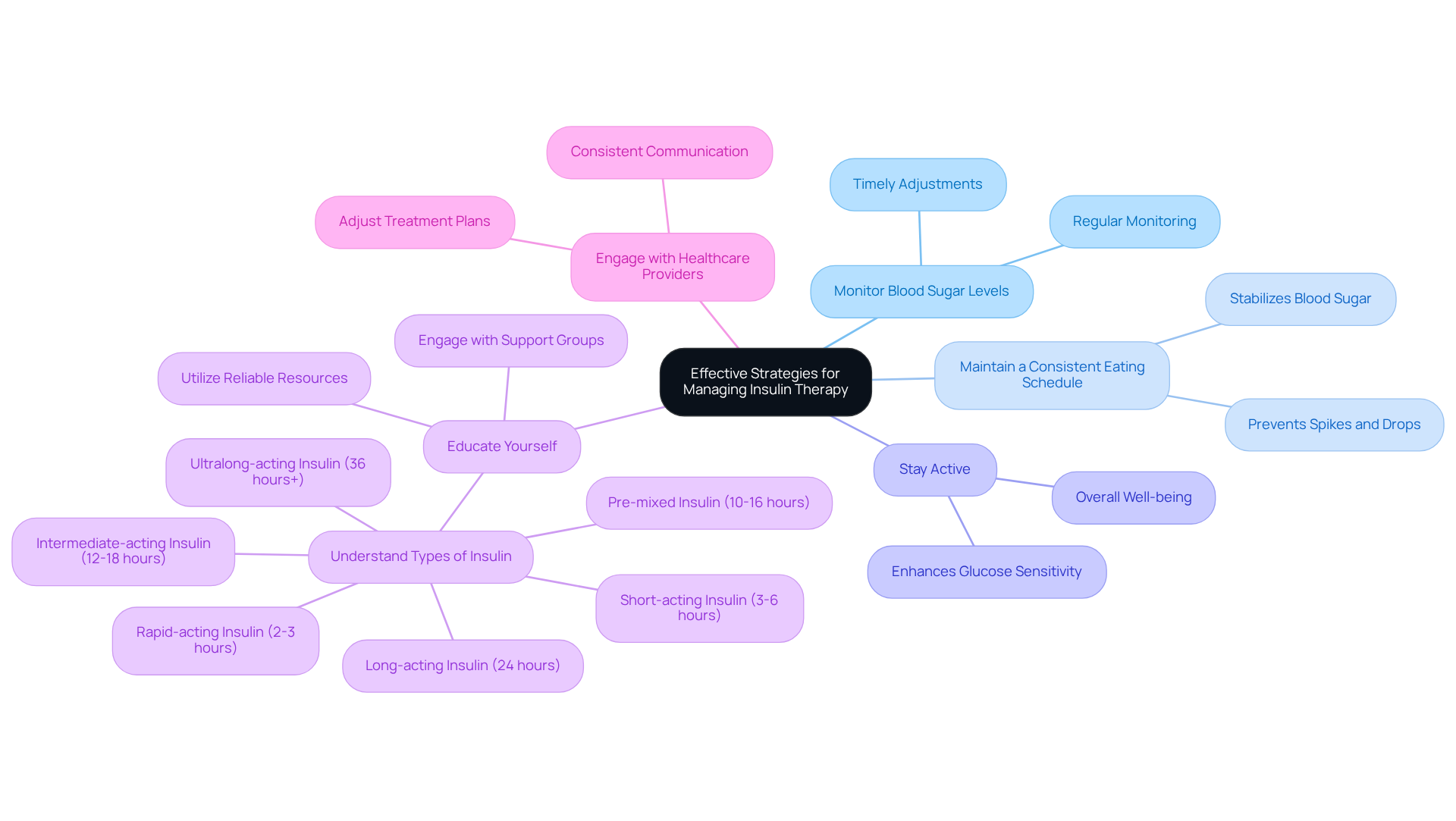Overview
This article highlights effective techniques and strategies for managing Type 2 diabetes through insulin therapy. It’s essential to understand the different types of insulin available, as well as to master the administration techniques. Regular blood sugar monitoring and maintaining a consistent eating schedule are vital strategies that empower you to take control of your diabetes management.
You're not alone in this journey. Many individuals find that understanding these elements can significantly improve their quality of life. By learning how to manage your diabetes effectively, you can feel more confident and in control. Remember, seeking support and resources can make a world of difference.
We are here to support you every step of the way. Implementing these strategies may seem overwhelming at first, but with time, you will find a rhythm that works for you. Each small step you take towards managing your diabetes is a step towards a healthier and more fulfilling life.
Introduction
Understanding the complexities of Type 2 diabetes can indeed feel overwhelming, particularly when it comes to managing insulin therapy. It's important to recognize that as the body becomes resistant to insulin, finding effective treatment options becomes essential for maintaining stable blood sugar levels. This article aims to explore the various types of insulin available, practical administration techniques, and strategies for effective management. By doing so, we hope to empower you to take control of your health.
You might wonder, how can one navigate the intricacies of insulin therapy to ensure optimal diabetes management while minimizing anxiety and uncertainty? You're not alone in this journey, and together we can find the answers that will help you feel more confident and supported.
Explore the Basics of Type 2 Diabetes and Insulin Therapy
Type 2 diabetes is a long-term condition characterized by the body's resistance to insulin, which means it doesn't utilize this vital hormone effectively. When lifestyle changes and oral medications are insufficient to manage blood sugar levels, shots for diabetes type 2 may be introduced. Insulin plays a crucial role in lowering blood glucose by helping cells absorb glucose for energy. Understanding how insulin works and its importance in managing blood sugar, particularly with respect to shots for diabetes type 2, is essential for you, as it empowers you to make informed decisions about your treatment options.
You're not alone in this journey. Gaining knowledge about your condition can help you actively participate in your care and work collaboratively with your healthcare providers. Remember, we are here to support you every step of the way. If you have questions or need guidance, don’t hesitate to reach out for resources or support.

Identify Different Types of Insulin for Type 2 Diabetes Management
Managing Type 2 diabetes effectively can feel overwhelming, but understanding the different types of shots for diabetes type 2 available can empower you on this journey. Each type is categorized by its onset, peak, and duration of action, and knowing these details can help you make informed decisions about your care.
- Rapid-acting insulin: This type begins to work within 15 minutes, peaks in 1-2 hours, and lasts for 2-4 hours. Medications like lispro and aspart are commonly used to help manage blood sugar spikes after meals.
- Short-acting insulin: Taking about 30 minutes to begin its effect, this insulin peaks in 2-3 hours and lasts for 3-6 hours. Regular insulin is a well-known example, suitable for managing blood glucose levels during meals.
- Intermediate-acting insulin: This insulin starts to take effect in 2-4 hours, peaks in 4-12 hours, and lasts for 12-18 hours. NPH is often used for basal coverage, providing a steady level of insulin.
- Long-acting insulin: Offering a steady release over 24 hours with no pronounced peak, long-acting varieties like glargine and detemir are crucial for maintaining stable blood sugar levels throughout the day and night.
- Premixed formulations: These combine rapid or short-acting insulins with intermediate-acting types, providing convenience for those who prefer fewer injections.
Real-life experiences highlight the effectiveness of these insulin types. Many patients using rapid-acting insulin report improved post-meal glucose management, while those on long-acting treatments appreciate the stability it offers throughout the day. As Dr. Sylvester Quevedo from Stanford Medical School notes, "The issue of health literacy is at the heart of this. My sense is that there will be a push to make healthcare more patient-centered."
Current trends show a growing preference for customized treatment plans, including shots for diabetes type 2, with healthcare providers increasingly focusing on patient-centered approaches. Recent advancements in insulin preparations promise better effectiveness and convenience, further enhancing the management of shots for diabetes type 2. By understanding these types of insulin and their characteristics, you can work closely with your healthcare provider to tailor your treatment plan to your needs.
Additionally, the incorporation of continuous glucose monitoring (CGM) technology, which has a noted 15-minute delay, can greatly assist in managing insulin therapy and improving overall blood sugar regulation. Remember, you're not alone in this journey. T2DSolutions is here to be a valuable resource, offering education and support to help you navigate your options and improve your health.

Master Insulin Administration Techniques and Best Practices
Mastering insulin administration techniques, particularly shots for diabetes type 2, is essential for effective diabetes management, and we understand how important this is for you. Let’s explore some key techniques and best practices that align with the resources available at T2DSolutions:
-
Gather Supplies: First, it's crucial to have the right insulin, syringes or pens, alcohol wipes, and a sharps container for disposal. Don’t worry; the company provides guidance on where to find these supplies to make this easier for you.
-
Choose the Injection Site: Common sites for injections include the abdomen, outer thigh, and back of the upper arm. Remember to rotate your injection sites to prevent lipodystrophy. You’re not alone in this; community support from this organization can help you connect with others who share their experiences.
-
Prepare the Injection: Before injecting, clean the site with an alcohol wipe. If you’re using a vial, draw the correct dose into the syringe. For pens, attach a new needle and dial the correct dose. Educational resources at this company can provide additional tips on preparation, ensuring you feel confident.
-
Inject the Insulin: Pinch the skin to create a fold, insert the needle at a 90-degree angle (or 45 degrees for thinner individuals), and inject the insulin slowly. Hold the needle in place for a few seconds to ensure complete delivery. The company emphasizes the importance of proper technique for effective management, and we’re here to support you in this process.
-
Dispose of Needles Safely: After use, place your needles in a sharps container immediately to prevent injury. This organization offers guidance on safe disposal practices, making it easier for you to stay safe.
By adhering to these steps, you can improve the efficacy of your hormone therapy and lessen any anxiety related to shots for diabetes type 2 injections. If you need additional assistance and resources, consider checking out your extensive center for Type 2 condition education and community aid. Remember, you’re not alone in this journey; we are here to support you every step of the way.

Implement Effective Strategies for Managing Insulin Therapy
To manage insulin therapy effectively, consider the following strategies, supported by T2DSolutions, your new resource hub for Type 2 diabetes education and community support:
- Monitor Blood Sugar Levels: Regularly checking blood glucose levels is crucial for understanding how this hormone affects your body. This practice allows for timely adjustments to dosages, ensuring optimal control.
- Maintain a Consistent Eating Schedule: Consuming food at consistent times stabilizes blood sugar levels, promoting improved glucose control. This consistency helps prevent spikes and drops in glucose levels.
- Stay Active: Incorporating physical activity into your daily routine significantly enhances sensitivity to glucose. Exercise not only aids in blood sugar control but also contributes to overall well-being.
- Educate Yourself: Staying informed about diabetes care and hormone treatment is vital. Utilize reliable resources, including those available through T2DSolutions, and engage with support groups to enhance your understanding and skills.
- Engage with Healthcare Providers: Consistent conversations with your healthcare team regarding your medication plan and any difficulties you face are crucial. This collaboration allows for necessary adjustments to your treatment plan.
Applying these strategies can lead to enhanced blood sugar regulation and a higher quality of life for individuals managing Type 2 diabetes. Understanding the various forms of this hormone—like long-acting variants, which endure for roughly 24 hours, and rapid-acting types, which function for 2 to 3 hours—can assist in customizing your approach to hormone therapy effectively. Remember, as a specialist in blood sugar control notes, "Effective insulin use is about understanding your body’s needs and adjusting accordingly." By embracing these practices and utilizing the resources available at T2DSolutions, you can navigate your diabetes management journey with greater confidence and success. You're not alone in this journey; we are here to support you every step of the way.

Conclusion
Understanding and effectively managing Type 2 diabetes, especially through insulin therapy, is vital for maintaining your health. It’s important to be informed about the various insulin options and administration techniques available to you. This knowledge can empower you to take charge of your diabetes management. By grasping the differences between insulin types, such as rapid-acting and long-acting varieties, you can collaborate closely with your healthcare providers to tailor your treatment plan, ensuring better blood sugar control.
Key insights from this article highlight the different categories of insulin, the importance of proper administration techniques, and the necessity of regular monitoring and lifestyle adjustments. From gathering the necessary supplies to engaging actively with your healthcare professionals, each step you take contributes to a more effective management strategy. Additionally, the role of community support and educational resources, such as those offered by T2DSolutions, is crucial in helping you navigate your diabetes journey with confidence.
Ultimately, the path to mastering insulin therapy and managing Type 2 diabetes lies in continuous education, self-advocacy, and utilizing available resources. By adopting the strategies discussed and staying informed about your treatment options, you can significantly enhance your quality of life and achieve better health outcomes. Embracing this proactive approach not only fosters your independence but also reinforces the message that support is always available. Remember, you’re not alone in this journey; together, we can make it less daunting and more manageable.
Frequently Asked Questions
What is Type 2 diabetes?
Type 2 diabetes is a long-term condition where the body becomes resistant to insulin, meaning it does not effectively utilize this crucial hormone to manage blood sugar levels.
When might insulin shots be necessary for Type 2 diabetes?
Insulin shots may be introduced when lifestyle changes and oral medications are insufficient to manage blood sugar levels.
How does insulin help manage blood sugar levels?
Insulin plays a crucial role in lowering blood glucose by aiding cells in absorbing glucose for energy.
Why is it important to understand insulin therapy for Type 2 diabetes?
Understanding how insulin works and its importance in managing blood sugar empowers individuals to make informed decisions about their treatment options.
How can patients participate in their diabetes care?
Gaining knowledge about their condition allows patients to actively participate in their care and collaborate effectively with healthcare providers.
What should patients do if they have questions about their condition?
Patients are encouraged to reach out for resources or support if they have questions or need guidance regarding their condition.



